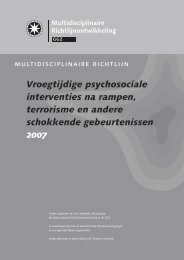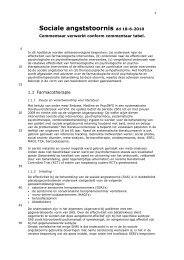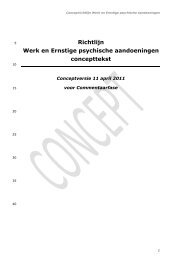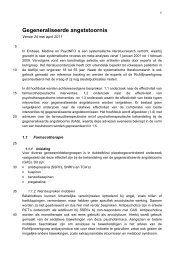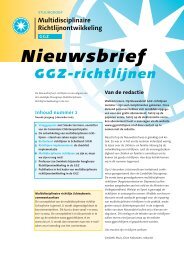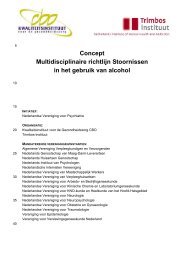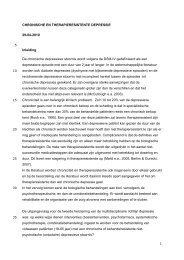Angststoornissen - Vereniging EMDR Nederland
Angststoornissen - Vereniging EMDR Nederland
Angststoornissen - Vereniging EMDR Nederland
Create successful ePaper yourself
Turn your PDF publications into a flip-book with our unique Google optimized e-Paper software.
SOCIALE ANGSTSTOORNIS<br />
Maak onderscheid tussen het gegeneraliseerde subtype en het specifieke subtype. Bij<br />
het gegeneraliseerde subtype kan doorgaans het beste worden gestart met hetzij exposure<br />
in vivo (met name wanneer vermijding centraal staat) of cognitieve herstructurering<br />
(met name wanneer disfunctionele cognities centraal staan). Wanneer de<br />
gekozen behandeling onvoldoende effect heeft kan de behandeling worden gecombineerd<br />
met sociale vaardigheidstraining (met name wanneer gebrekkige sociale vaardigheden<br />
centraal staan) of met taak concentratie training (met name wanneer overbetrokkenheid<br />
op het eigen functioneren centraal staat). Wanneer nog steeds onvoldoende<br />
resultaat wordt bereikt, kan in de hoofdinterventie worden ‘geswitched’ van<br />
exposure naar cognitieve herstructurering of andersom.<br />
Bij het specifieke subtype sociale fobie worden dezelfde beslisprocedures toegepast,<br />
zij het dat sociale vaardigheidstraining doorgaans geen ondersteunende interventie<br />
zal zijn naast exposure in vivo en/of cognitieve herstructurering.<br />
Literatuur<br />
Clark DM, Wells A. A cognitive model of social phobia. Heimberg, R. G., Liebowitz, M., Hope, D. A.,<br />
and Schneier, F. R. In: Social Phobia: Diagnosis, Assessment and Treatment. 2002.<br />
Dam-Baggen R, Kraaimaat F. Group social skills training or cognitive group therapy as the clinical<br />
treatment of choice for generalized social phobia? J Anxiety Disord 14: 437-51, 2000.<br />
Fedoroff IC, Taylor S. Psychological and pharmacological treatments of social phobia: a meta- analysis.<br />
J Clin Psychopharmacol 21: 311-24, 2001.<br />
Feske U, Chambless DL. Cognitive-behavioral versua exposure only treatment for social phobia: a<br />
meta-analysis. Behavor Therapy 26: 695-720, 1995.<br />
Gould RA, Buckminster S, Pollack MH, Otto MW, Yap L. Cognitive-behavioral and pharmacological<br />
treatment for social phobia: a meta-analysis. Clinical Psychology: Science and practice 4: 291-306,<br />
1997.<br />
Heimberg RG. Cognitive-behavioral therapy for social anxiety disorder: current status and future directions.<br />
Biol Psychiatry 51: 101-8, 2002.<br />
Heimberg RG, Salzman D, Holt CS, Blendell K. Cognitive-behavioural group treatment for social phobia:<br />
effectiveness at five-year folow-up. Cognitive therapy and Research 17: 325-39, 1993.<br />
Hofmann SG, Newman MG, Ehlers A, Roth WT. Psychophysiological differences between subgroups of<br />
social phobia. J Abnorm Psychol 104: 224-31, 1995.<br />
Mattick RP, Peters L. Treatment of severe social phobia: effects of guided exposure with and without<br />
cognitive restructuring. J Consult Clin Psychol 56: 251-60, 1988.<br />
Mersch PP. The treatment of social phobia: the differential effectiveness of exposure in vivo and an<br />
integration of exposure in vivo, rational emotive therapy and social skills training. Behav Res Ther 33:<br />
259-69, 1995.<br />
Mersch PP, Emmelkamp PM, Lips C. Social phobia: individual response patterns and the long-term<br />
effects of behavioral and cognitive interventions. A follow-up study. Behav Res Ther 29: 357-62,<br />
1991.<br />
Mulken S, Bogels SM, de Jong PJ, Louwers J. Fear of blushing: effects of task concentration training<br />
versus exposure in vivo on fear and physiology. J Anxiety Disord 15: 413-32, 2001.<br />
Rapee RM, Heimberg RG. A cognitive-behavioral model of anxiety in social phobia. Behav Res Ther 35:<br />
741-56, 1997.<br />
Rapee RM, Lim L. Discrepancy between self- and observer ratings of performance in social phobics. J<br />
Abnorm Psychol 101: 728-31, 1992.<br />
Scholing A, Emmelkamp PM. Cognitive and behavioural treatments of fear of blushing, sweating or<br />
trembling. Behav Res Ther 31: 155-70, 1993.<br />
Scholing A, Emmelkamp PM. Exposure with and without cognitive therapy for generalized social phobia:<br />
effects of individual and group treatment. Behav Res Ther 31: 667-81, 1993.<br />
Scholing A, Emmelkamp PM. Treatment of fear of blushing, sweating, or trembling. Results at longterm<br />
follow-up. Behav Modif 20: 338-56, 1996.<br />
Scholing A, Emmelkamp PM. Treatment of generalized social phobia: results at long-term follow-up.<br />
Behav Res Ther 34: 447-52, 1996.<br />
Taylor S. Meta-analysis of cognitive-behavioral treatments for social phobia. J Behav Ther Exp Psychiatry<br />
27: 1-9, 1996.<br />
Turner SM, Beidel DC, Cooley-Quille MR. Two-year follow-up of social phobics treated with social effectiveness<br />
therapy. Behav Res Ther 33: 553-5, 1995.<br />
Wells A, Papageorgiou C. Social phobic interoception: effects of bodily information on anxiety, beliefs<br />
and self-processing. Behav Res Ther 39: 1-11, 2001.<br />
85






